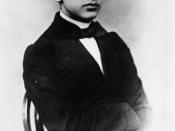An analysis of Tchaikovsky's Symphony in F Minor.
The Symphony in F Minor is a standard four movement piece written in the key of F minor. Tchaikovsky composed this piece between 1877 and 78. He wrote it during the time of his disastrous marriage to Antonia Milyukova. Because of this, one can assume that the great passions and contrasts that are written into the symphony are a result of his marriage. But this might not be completely true, because it is rumored that the piece is actually dedicated to his patron Madame von Meck. Tchaikovsky himself described it as a "musical confession of the soul."4 The information concerning the first performance of the Forth Symphony is very sketchy, but there are some things that can assumed. For instance, one can assume that the piece was first performed in St Petersburg, since that is to where Tchaikovsky fled after his marriage fell apart, and that Tchaikovsky was the conductor since that was commonplace for the style period.
As to greater detail, due to lack of information, it is just not possible.
FIRST MOVEMENT:
The first movement of the Forth Symphony is the longest of the four movements. It starts out with the brass instruments in a sort of brass fanfare with a fast tempo to move the music along. I found that throughout this piece, Tchaikovsky really makes use of the crescendos and decrescendos and, in fact, I would have to say that this is probably the element for which impacts the movement the most. He really makes large jumps between loud and soft because of the heavy use of the horns in this movement. The other element that impacts the most is the tempo. He never separates the two. For example, every time the music goes soft, the tempo...



Good!
The personal insights make it a great essay!
2 out of 2 people found this comment useful.